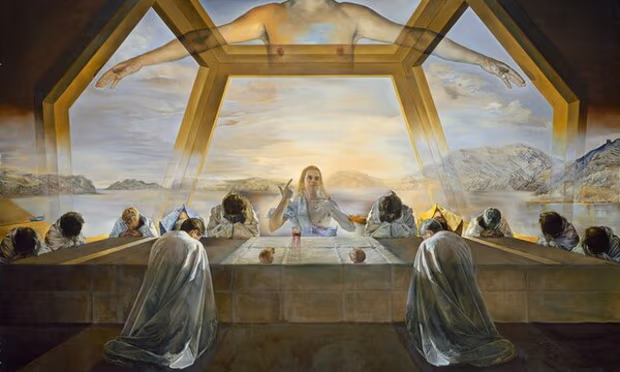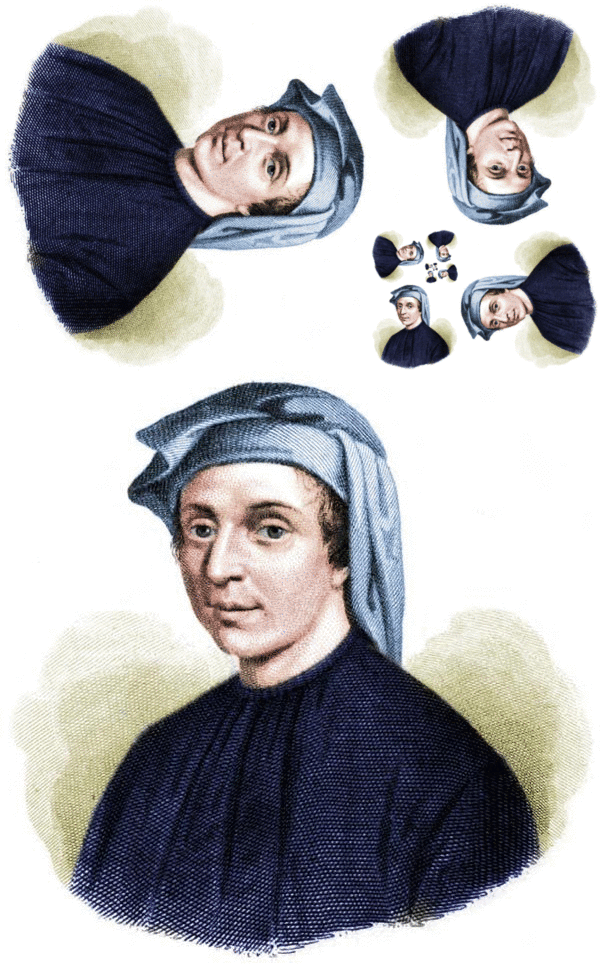- We talked through a few examples of Fibonacci Nim: it's good to
practice the strategy, to make sure that you can play it and
beat me. I don't want to take your points during the quiz.
- I introduced the most beautiful rectangle in the whole world (the
Golden Rectangle), and the Fibonacci spiral which approximates it.
I claimed that Fibonacci spirals are beloved by nature, and today I'll show you a few more examples of that.
A "Fibonacci Spiral" is created as follows:
- Start with a small square (which is also a rectangle); then
- append the largest square you can to the current rectangle.
- Do it again, and again, proceeding in a consistent sense (e.g. clockwise)
- Salvador Dali's The Sacrament of the Last Supper

That gives it a side length ration of what? 267/166.7 = ???
If it were two centimeters wider, it would have been golden.
- Fibonacci numbers also have a connection to this
beautiful concept of the golden ratio: what the Fibonacci
spiral shows us is that the ratio of side lengths is converging
on a number, which is the Golden ratio. (see this site for
more on these spirals).
We're going to "do it again!" now: let's build another one: but this time, we'll keep our focus on the Fibonacci numbers.
- Ordinarily we build the Fibonacci spiral by building bigger and
bigger rectangles. The shapes of the rectangles change as we go
along, in such a way that the ratio of side lengths are
Fibonacci numbers. Let's look at the sequence of the ratios....
So let's break down the spiral building process, with a focus on those side ratios.
- Start with a piece of graph paper (the wide way), and darken the square in the 10,10 spot (ten from the left, ten down from the top). You might want several colors, if you've got them -- might as well make this look great!
- Rule: attach the largest square you can: first left, then down, and then continue in a counter-clockwise fashion.
- As you add each square you create a new rectangle. Compute the ratio of side lengths (larger over smaller).
- Do it again, do it again, do it again! (You could do it forever -- but we run out of paper.)
- What do you notice about the dimensions of the rectangle? It's the
ratio of those dimensions that interests us most -- the ratio
of dimensions (larger to smaller) dictates the shape of the
rectangle. Two rectangles that have the same ratio have the
same shape.
1x1 1/1=1 2x1 2/1=2 3x2 3/2=1.5 5x3 5/3=1.67 8x5 8/5=1.6 13x8 13/8=1.625 21x13 21/13=1.615 34x21 34/21 \(\approx\) 1.619 
-
If you did your reading (and of course you did!), you know that the
ratios of side lengths of these rectangles -- that is, the ratios of
successive Fibonacci -- numbers tend toward a certain number,
which is called the "golden mean" or "golden ratio":
\[
\varphi=\frac{1+\sqrt{5}}{2} (\approx 1.618033988749895)
\]
- The rectangle we are approaching is the so-called golden rectangle,
whose side-lengths are in the ratio called "the golden
ratio". But we will derive the golden rectangle in a different
way -- the way that the Greeks did it! When we're done, we'll
have also defined the golden mean, aka the golden ratio.
- Begin with a rectangle.
- Remove the largest square possible from the rectangle, to leave a rectangle.
- If the rectangle that results has exactly the same shape as the original
rectangle, then that rectangle is golden:
However if we look back at the Fibonacci spiral sequence of rectangles as they're growing, we see that they're tending toward a "golden rectangle".
-
At the heart of the golden rectangle, at the focal point of the golden
spiral, is ... well, an infinitesimally small golden rectangle! It
never stops: it's exactly the same rectangle at each step, only
smaller. This is called a fractal: a perfect copy of the world
inside the world.
The Fibonacci numbers also exhibit this "fractal nature", as we might recall from the rabbit problem. This is because each rabbit pair behaves exactly like every other pair at its particular stage of maturation. (We will discuss fractals further down the road.)
- Let's show that this golden ratio is, in fact, the side-length ratio of
the golden rectangle described above. And our secret weapon will be
your old friend, that old favorite, the formula you were told to expect
one day, like Santa Claus coming down the chimney just in time: the
quadratic formula!
While we might think about the Fibonacci spirals as being created by attaching squares, the golden rectangle is created by removing squares. We just do things backwards....
We can build beautiful rectangles by pasting squares together, or we can define beautiful rectangles by taking them away....
- Begin with a golden rectangle with dimensions \(\varphi \times 1 \).
- Remove the largest square possible from the rectangle, to leave a rectangle with dimensions \(1 \times (\varphi - 1)\).
- The rectangle that results has exactly the same shape as the original
rectangle: therefore the ratio of its side lengths is
the same as the original: that means that
\[
\frac{\varphi}{1} = \frac{1}{\varphi - 1}
\]
- This becomes the quadratic equation \[ \varphi^2-\varphi-1 = 0 \] (cross multiply and take everything to the left side).
- Pull that quadratic formula out of the dim recesses of your mind and you'll find two solutions: \[ \varphi=\frac{1 \pm \sqrt{5}}{2} \] Why do we choose the "+" solution?
- Now what can we do with these ideas? Here is a somewhat silly
example -- A Fibonacci spiral fractal comic I made recently, which I
have titled "Flirting with Death Spiral". Infinite fun!

(sidelengths: 466x288, with ratio 1.6180555555555556!)
You'll be making these, too, soon, using your own photos. Let's do one in class now (if we're lucky this will work!)
- Fibonacci
Spiral Fractal maker, to make images like these:

- How to win at Nim
- Logo Design using the Golden Ratio
- A review of the Mayan calendar we study, Unearthing the Heavens: Classic Maya Murals and Astronomical Tables at Xultun, Guatemala , including the reference to this article from the journal Science: Ancient Maya Astronomical Tables from Xultun, Guatemala, and this more "popular" interpretation of the calendar.
- Do math like an Egyptian! (Walk Like An Egyptian/Michael Jackson Mash-up!)
- Hexagonal Paper
- Pascal's triangle (wikipedia)
- American Bandstand dances to Gimme Some Lovin', a hit by The Spencer Davis Group: here's their version.
- List of musical works in unusual time signatures
- Blue Rondo a
la Turk, by Dave Brubeck: illustrating
how to play a piece in 9/8.
Watch Dave Brubeck's leg, counting out the rhythm....